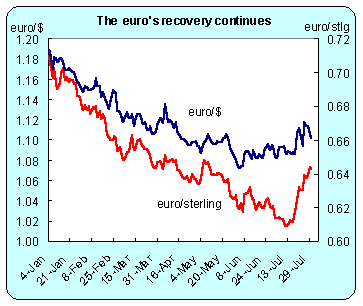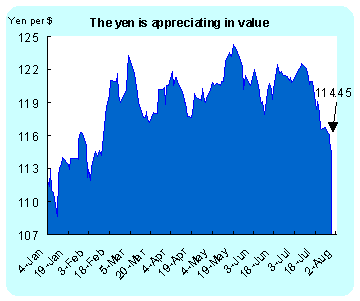|
International Perspective August 2, 1999
Anne D. Picker,
International Economist
Signs of Growth
| A number of indicators were released this week that give a perspective on the global economic outlook. |
United Kingdom shows renewed vigor
The British economy grew at its fastest pace in a year in the second quarter, putting recession fears to rest. Gross domestic product expanded 0.5 percent when compared with the first quarter and 1.2 percent when compared with the second quarter of 1998. The good news was that the beleaguered manufacturing sector is emerging from its recession after being overshadowed by the larger service sector in recent years.
Not long ago, it seemed as though Britain was headed for a recession. However, the low point - reached in the fourth quarter of 1998 - was flat, not negative. Even though manufacturing was faltering, unemployment managed to stay near a 19 year low and employment continued to rise. Interest rates, cut seven times in the last ten months, fell to a 22 year low of five percent. This spurred factories to step up production, and invigorate exports and consumer spending.
Despite these interest rate cuts, inflation continues to run below the target set by the Bank of England and Chancellor of the Exchequer Gordon Brown of 2.5 percent. The Bank of England Monetary Policy Committee, who is responsible for setting interest rates, measures its success by monitoring the retail price index less mortgages. The Bank of England has controlled interest rate levels since May 1997 and appears to have done a good job of cutting interest rates to stimulate the economy.
Britain, although a member of the European Union, has remained out of the European Monetary Union by choice for a variety of political and economic reasons. Prime Minister Tony Blair reiterated again this week that the country still would like to join the European Monetary Union at some time in the future, but is in no hurry to do so.
Euroland is more optimistic
Following up on the favorable reading of the Ifo survey in Germany last week, both Italy and France produced positive survey readings of their own. In France, the MNI survey said that industry executives' overall outlook continued to improve pointing to stronger output ahead. Total orders and foreign demand also improved. The conclusion is that industry pessimism no longer threatens French economic recovery. In Italy, the latest survey by ISAE of business sentiment also shows a marked improvement in the current situation barometer for both industrial output and orders. This also implies that an economic upturn is close at hand. These results followed an ISAE consumer confidence survey that also showed sharp improvement in attitudes. The stirrings of a recovery will once again increase U.S. export opportunities in Europe.
Asia has bottomed out
There was both good economic news and bad from Japan this week. The good news was that industrial activity jumped three percent in June, far exceeding the Ministry of International Trade and Industry's (MITI) forecast. A MITI survey of production shows that producers anticipate a 0.5 percent increase in July and a jump of 3.7 percent in August. The bad news was unemployment reached a post war high of 4.9 percent. Both consumer spending and average monthly cash earnings declined. Although the economy has produced many favorable signs recently, the economy is not out of the woods yet despite the rising stock market and rising value of the yen.
Latin America dodges a bullet
Latin American economies remain fragile with many problems. However, Argentina and Brazil did take steps to resolve their trade conflict late last week. Mercosur, the South American trade bloc, is attempting to avoid a damaging internal conflict now that Argentina has agreed to withdraw potential restrictions on imports from its neighbors. Officials from the four Mercosur member nations - Brazil, Argentina, Uruguay and Paraguay - will resume negotiations on trade issues on Wednesday, which Brazil had suspended as a protest to Argentina's actions. The dispute is the most serious in a number of recent conflicts between Brazil and Argentina, the two biggest members of the seven-year-old trading bloc. Latin America has close economic and political ties to the United States and their economic well being is critical to us.
What does this mean for U.S. investors?
The outlook is shifting. The data are showing that the Asian and European economies have reached the bottom and are stirring - with promise of greater growth and investment opportunities. This is good news for American exporters, but could be troublesome if an export boom is superimposed on already burgeoning domestic demand. The United States will no longer have to be the importer of last resort, and that will help the trade balance going forward. The strength of the dollar against the euro and the yen had been driven, in large part, by the very different outlooks for growth in the world's big economies. Now this is changing.
Financial Markets
World Stock Exchanges
Last week, the Japanese and South Korean stock indexes recovered a large portion of the losses sustained in the previous week. The Japanese and South Korean markets have benefited from investment community perceptions that their economic problems have been solved and growth has renewed, despite remaining structural problems. In London, the FTSE 100 also edged higher this week in spite of trader's jitters.
There are several reasons for last week's volatility. The markets continued to focus on Federal Reserve Chairman Alan Greenspan's semi annual Humphrey Hawkins testimony. They listened closely to see if there was any change in inflection between his testimony before a House of Representatives' committee on July 22nd and that before a Senate committee this past Wednesday. The markets are continuing their never ending search for clues about U.S. interest rate policy. U.S. economic indicators also roiled the markets as employment costs climbed more than expected and gross domestic product grew slower than expected. August is the start of the big vacation season in Europe and many vacationers were looking to square their positions before leaving for the rest of the summer. Summer doldrums are definitely a market factor.
The table below gives last week's changes in the world's key stock indexes.
| Selected World Stock Market Indexes |
| Index | 30-Jul | 1999
High | 1999
Low | Week %
Change |
|---|
| Asia |
| Australia | All Ordinaries | 3019.90 | 3145.20 | 2804.80 | -1.64 |
| Japan | Nikkei 225 | 17861.86 | 18357.90 | 13232.70 | 1.87 |
| Hong Kong | Hang Seng | 13186.86 | 14506.74 | 9076.33 | 0.71 |
| S. Korea | Korea Composite | 969.72 | 1027.93 | 498.42 | 7.16 |
| Europe |
| Britain | FTSE 100 | 6231.90 | 6420.60 | 5770.20 | 0.39 |
| France | CAC |
4382.06 | 4697.80 | 3958.70 | -1.31 |
| Germany | XETRA DAX | 5101.87 | 5652.00 | 4668.50 | -3.93 |
| North America |
| United States | Dow | 10655.15 | 11209.80 | 9120.70 | -2.34 |
| Canada | TSE Composite 300 | 7080.70 | 7292.70 | 6180.30 | 0.16 |
| Mexico | Bolsa | 5260.22 | 7292.70 | 6180.30 | -6.29 |
Currencies
The euro
The markets are keeping a close eye on the euro, which is riding high on recent positive economic data. The euro's appreciation against the dollar was momentarily halted on Tuesday after Ernst Welteke, president elect of the German central bank (the Bundesbank) was quoted as saying that exporters in the eurozone could suffer if the euro became too strong. This would make exports from the eurozone more expensive in foreign markets. This is the same effect that the strong dollar has had on American exports, making them more expensive in foreign markets. The weak euro has helped exporters but also carries an inflation risk by making imports more expensive.

Sterling is benefiting from the strength of the British economy. However, the eurozone may have greater near term growth potential because of excess productive capacity. It also has a more competitive exchange rate. Trade will probably boost the eurozone growth but will be a drag on the United Kingdom because of its huge trade deficit. The euro should continue its strong performance as economic data confirm that there is a pickup in growth in the key economies - Germany, France and Italy. However, their structural problems with fiscal policy and in the labor markets won't go away.
The Yen
The dollar fell to a five month low against the yen on expectations that international investors will buy the Japanese currency to invest in equities there. The yen's strength is seen as an obstacle to Japan's fragile economy recovery. With the Japanese industrial sector being supported by the strength of exports to Asia and the dollar being hurt by the improvement in European growth relative to the United States, Japanese officials are likely to have a hard time preventing the yen from going higher. The yen continues to rise against the dollar (that is, fewer yen per dollar) despite efforts of the Ministry of Finance to talk down the yen. They seem to have given up on intervention in the foreign exchange markets for now.

Why U.S. investors care...
With the U.S. economy showing signs of finally slowing down and the Asian and European economies beginning to stir, some interesting prospects exist for U.S. investors in overseas markets, especially in Europe.
Looking Ahead
The following indicators will be released this week.
| Europe | | |
| August 2 | France | Producer Price Index (June) |
| UK | Manufacturing Report (July) |
| August 3 | UK | Construction Report (July) |
| August 4 | France | Consumer sentiment (July) |
| UK | Services Report (July) |
| UK | Bank of England Monetary Policy Committee meeting (2 days) |
| August 5 | UK | Industrial Production (June) |
| UK | Bank of England Monetary Policy Committee Meeting |
| Germany | Unemployment (July)
Manufacturing Orders (June) |
| EU | Business and Consumer Survey (July) |
| August 6 | UK | Housing Starts (June) |
| Italy | Industrial Production (June) |
| France | Balance of Payments (May) |
| North America | | |
| August 4 | Canada | Building Permits (June) |
| August 6 | Canada | Labor Force Survey (July) |
For U.S. data releases, see this week's Simply Economics.
|



